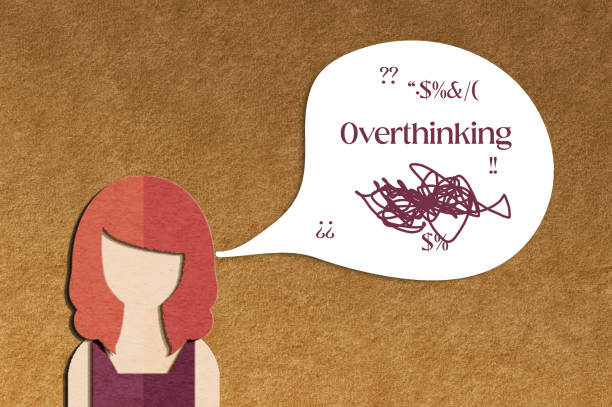We sometimes include products we think are useful for our readers. If you buy through links on this page, we may earn a small commission.Read our affiliate disclosure
Best books to Read – https://amzn.to/3QDb0m8
Discover a path to greater well-being and happiness by conquering the pervasive issue of overthinking. In this insightful guide, we present practical strategies to break free from the cycle of overanalyzing and find a happier mindset. Explore eight effective techniques that not only address overthinking but also promote holistic wellness. Say goodbye to Overthinking and welcome a more peaceful, fulfilling life with our proven methods.
1. How you stop Overthinking about the problem.

99% of the harm is caused in your head, by you and your Overthinking thoughts. 1% of the harm is caused by reality, what actually happens and the outcome. Most of the time, the problem isn’t the problem. The way you think about the problem is.
Example to illustrate the concept that “the problem is rarely the problem, but rather how you Overthinking about the problem.”
Imagine a person, let’s call them Alex, who is facing a challenging situation at work. They have a tight deadline for a project, and things are not going as smoothly as planned. Alex encounters an unexpected issue that needs to be resolved.
The Problem: The objective issue is the tight deadline and the unexpected problem in the project.
Potential Reactions:
- Negative Thinking:
- Alex could start thinking, “This is a disaster. I can’t handle this. Everything is falling apart.”
- This negative thinking might lead to stress, anxiety, and a sense of being overwhelmed.
- Positive Thinking:
- On the other hand, Alex could think, “This is a challenge, but I can find a solution. I’ve overcome obstacles before, and I can do it again.”
- Positive thinking can lead to a more focused and solution-oriented approach.
Outcome:
- If Alex dwells on negative thoughts, the stress and anxiety might impact their performance. The problem might seem insurmountable, affecting the overall outcome of the project.
- If Alex adopts a positive mindset, they are more likely to approach the problem with a clear head, seeking solutions and potentially mitigating the impact of the unexpected issue. This positive outlook can contribute to a better outcome and a more successful resolution of the problem.
In this example, the tight deadline and unexpected problem are the same in both scenarios. The difference lies in how Alex perceives and thinks about the problem, significantly influencing the emotional and practical response and, ultimately, the outcome.
2. Avoid self-rejection.

Don’t think you deserve that opportunity? Apply for it anyways.Don’t think your article is good enough? Publish it anyways.Don’t think they’ll reply to your email? Send it anyways.Never overthink yourself into self-rejection.
Let’s consider an example to illustrate the importance of avoiding self-rejection and taking opportunities even when self-doubt creeps in.
Situation: Imagine a person named Taylor who is passionate about photography but has never considered submitting their work to a photography contest.
Self-Rejection Thoughts: Taylor takes some stunning photos but often thinks, “I’m not a professional photographer; my work isn’t good enough to compete with others in a contest. I’ll probably get rejected, so it’s not worth submitting.”
Avoiding Self-Rejection: Despite these self-doubts, Taylor decides to challenge their own negative thoughts and submits their favorite photo to a local photography contest.
Outcome: Surprisingly, Taylor’s photo not only gets shortlisted but wins an honorable mention. This recognition boosts Taylor’s confidence and opens up new opportunities. It turns out that Taylor’s work was indeed appreciated, even though self-doubt initially held them back.
Lesson Learned: In this example, Taylor’s initial Overthinking thoughts about Self-rejection could have led to missing out on an opportunity for recognition and growth. By pushing past self-doubt and taking the chance, Taylor not only gained external validation but also learned that sometimes our own perception of our abilities can be more critical than how others perceive us. This experience encourages Taylor to embrace opportunities without overthinking and underestimating their own potential.
3. Silence and time.

The truth is, most problems aren’t solved with more thinking, they’re solved with less. You’ll find most of the answers you’re looking for in silence, in time band with a clear mind. If you can’t solve a problem, stop trying to.
Let’s consider a scenario where the principle of “silence and time” plays a crucial role in problem-solving.
When you start criticizing yourself for past mistakes, or seeing disaster around every corner, ask yourself: “Is there anything I can do right now to change the past or to positively influence the future.” If the answer is yes, do it take action. If the answer is no, be at peace let it go. You have to take action or let it go, everything else is self-harm.
Situation: Imagine a person named Jordan who is facing a complex decision about a major career change. They are torn between staying in their current job, which offers stability but lacks fulfillment, and pursuing a new opportunity that aligns with their passion but involves more risk.
Initial Approach: Jordan has been grappling with this decision for weeks, constantly analyzing pros and cons, seeking advice from friends and family, and attempting to figure out the “perfect” solution.
Application of “Silence and Time”: One day, feeling overwhelmed and no closer to a resolution, Jordan decides to step back and give themselves some mental space. They take a weekend away from work, technology, and the constant mental chatter surrounding the decision.
Outcome: During this period of silence and time, away from the noise and pressure, Jordan gains clarity. The break allows them to reflect on their values, priorities, and long-term goals. In this clear-headed state, Jordan realizes that the new opportunity aligns more with their aspirations and personal fulfillment, despite the associated risks.
Lesson Learned: In this example, the constant thinking and analysis initially led to increased stress and indecision for Jordan. It was only when they took a step back, embraced silence, and allowed time for their thoughts to settle that the solution became apparent. This demonstrates the power of creating mental space and allowing time for clarity, often leading to more effective problem-solving. Sometimes, stepping away from actively trying to solve a problem can be the key to finding the best solution.
Related Stories from blowingbrainsz.com
- Life is Beautiful: Make These 9 Small Changes for a Beautiful Journey
- 12 Essential Tips for a Long and Happy Life
- “Power of Silence in Everyday Life”
- 12 Signs You’re Actually a Better Person Than You Think
- The 12 Laws Of Karma & How They Can Change Your Life
4. An important question.
Let’s consider a scenario where someone applies the principle of asking an important question to overcome self-criticism,Overthinking and anxiety.
Situation: Imagine a person named Alex who recently made a mistake at work that had some negative consequences. Alex finds themselves Overthinking on the error, feeling overwhelmed by self-criticism and worrying about the potential fallout.
Applying the Question: Alex takes a moment to reflect and asks themselves, “Is there anything I can do right now to change the past or positively influence the future?”
Possible Answers:
- If the answer is “Yes”: Alex realizes they can take action to mitigate the consequences. They decide to proactively communicate with their team, propose a solution to rectify the mistake, and implement steps to prevent similar errors in the future.
- If the answer is “No”: Alex recognizes that Overthinking on the mistake won’t change the past. They consciously choose to let go of the self-criticism, acknowledging that ongoing worry serves no purpose.
Outcome: In the case of “Yes,” taking action empowers Alex to address the mistake proactively and learn from it. In the case of “No,” choosing to let go brings a sense of peace and allows Alex to focus on moving forward rather than being stuck in self-harm through persistent negative thoughts/Overthinking.
Lesson Learned: This example highlights the importance of asking the question and taking either actionable steps or letting go, emphasizing that dwelling or Overthinking on past mistakes without a constructive purpose is detrimental to one’s well-being.
5. The power of now.
You’re not going to overthink your way to a better future. You’re not going to overthink your way to a better past. All you have is NOW. And what you do with NOW can make right of your past and make good of your future. Make peace with yesterday, let go of tomorrow, grab hold of now and STOP Overthinking.
Let’s consider a scenario involving an individual named Aisha to illustrate the power of living in the present moment.
Aisha’s Story: Aisha, an architect from Mumbai, often found herself Overthinking on missed opportunities and past decisions that didn’t go as planned. She also felt anxious about the uncertainties of the future, especially regarding her career and personal life.
Realization and Application: One day, Aisha came across the idea of “The Power of Now.” Inspired, she decided to embrace the present moment. Instead of overthinking her past choices or worrying about the future, Aisha focused on the current projects at work and the relationships she had in her life.
Example of Living in the Now:
- Career: Aisha started putting her full energy into her current architectural projects. She found that by being fully present in her work, she became more creative and effective, earning recognition from her colleagues and superiors.
- Personal Life: Aisha began spending quality time with her family and friends without the distraction of past regrets or future concerns. This strengthened her relationships and brought joy to her everyday life.
Outcome: By immersing herself in the present, Aisha experienced a positive transformation. She made peace with her past mistakes, recognizing them as opportunities for growth. Simultaneously, she let go of the paralyzing fear of an uncertain future, realizing that the actions she took in the present would shape her tomorrow.
Lesson Learned: Aisha’s journey illustrates the transformative power of embracing the present moment instead of Overthinking. By letting go of the baggage of yesterday and the anxieties of tomorrow, Aisha was able to make the most of her NOW, leading to personal and professional fulfillment.
6. Fact check your own thoughts.

Your thoughts will create scenarios in your mind that reflect your insecurities, fears and Overthinking worries. So it’s important to always fact-check your own thoughts before accepting them, because in highly emotional situations, your thoughts will tell you stories that aren’t true. Facts check yourself.
Let’s explore a short story to emphasize the importance of fact-checking one’s own thoughts.
Story: Meet Raj, a college student who was about to give a presentation to his class. As he prepared, thoughts of self-doubt and anxiety crept into his mind. “What if I mess up? They’ll think I’m not smart. I’ll embarrass myself in front of everyone.”
Fact-Checking Moment: Recognizing the negative thoughts, Raj decided to fact-check them. He asked himself, “Is there any evidence to support these thoughts?” Upon reflection, he realized that he had prepared thoroughly and had successfully presented before without any major issues.
Outcome: By fact-checking his thoughts, Raj shifted his perspective. He entered the presentation room with more confidence, delivered a compelling presentation, and received positive feedback from his classmates and the instructor.
Lesson Learned: In this story, Raj’s experience highlights how thoughts, especially in emotionally charged situations, can create fictional scenarios. By fact-checking his own thoughts, Raj was able to challenge the negative narratives, leading to a more accurate perception of the situation and a positive outcome. This demonstrates the power of questioning and verifying our thoughts, particularly when emotions are high.
7. Acceptance is peace.
No amount of anxiety will change your future; no amount of regret will change your past. Peace is found in acceptance: • Accept imperfection. • Accept uncertainty. • Accept the uncontrollable. You don’t have to understand, tolerate or even forget something, but if you want peace, you must accept it.

Let’s explore a short and beautiful story that embodies the theme of acceptance leading to peace above Overthinking.
Story: Meet Maya, a young artist who had recently experienced a series of setbacks in her career. Despite her talent, a prestigious gallery rejected her work, leaving her feeling disheartened and questioning her abilities.
Acceptance Journey: Maya initially struggled with feelings of self-doubt and frustration. However, she decided to embrace the concept of acceptance. Instead of dwelling on the rejection, she accepted the imperfection of the situation, acknowledging that not every opportunity would align with her art.
Unexpected Opportunities: As Maya started accepting the uncertainty of her artistic journey, she found solace in the process itself. Unbeknownst to her, this newfound acceptance attracted unexpected opportunities. A local community art project noticed her work and invited her to showcase her pieces, bringing recognition and appreciation.
Outcome: Through the practice of acceptance, Maya not only found peace within herself but also discovered that embracing imperfections and uncertainties opened doors to unexpected and fulfilling experiences in her artistic career.
Lesson Learned: Maya’s story illustrates that true peace often comes from accepting the inherent imperfections, uncertainties, and uncontrollable aspects of life. By letting go of the need for perfect outcomes, Maya found a sense of calm and unexpected success, emphasizing the transformative power of acceptance above Overthinking.
8. Health starts in your mind.
You can go to the gym, eat healthy, do yoga, drink water and take vitamins, but if you don’t directly confront the negativity in your thoughts, you will never truly be ‘healthy’. Our health isn’t measured on scales, by the size of our muscles or by the width of our waist. True health is measured by the quality of our thoughts and the peacefulness of our mind. Health starts in your mind.Top of Form
Let’s explore a short and crisp story that encapsulates the essence of how mental well-being is integral to overall health.
Story: Meet Sarah, a fitness enthusiast who diligently followed a strict exercise routine, maintained a balanced diet, and practiced yoga regularly. Despite her commitment to physical health, she found herself constantly stressed, anxious, and dissatisfied.
One day, a friend introduced Sarah to mindfulness meditation. Initially skeptical, Sarah decided to give it a try. Through consistent practice, she learned to confront and manage the negativity in her thoughts. As a result, her mental well-being improved significantly.
Surprisingly, Sarah noticed positive changes not only in her mindset but also in her overall health. The stress-induced headaches reduced, her sleep quality improved, and she felt a sense of calm that transcended the numbers on a scale or the appearance of her physique.
Sarah realized that true health wasn’t just about the external measures of fitness; it was deeply rooted in the quality of her thoughts and the peacefulness of her mind. From that point forward, she embraced a holistic approach to health, recognizing that a healthy mind was the foundation for a truly healthy life.
Lesson Learned: Sarah’s journey highlights that while physical practices contribute to health, addressing and nurturing the mind is equally vital. A holistic approach to well-being encompasses mental and physical aspects, emphasizing that health truly starts in the mind.
Finishing Overthinking.
As we wrap up our journey to conquer overthinking and cultivate a happier mindset, remember these key takeaways: practice mindful awareness to observe thoughts without judgment, foster positive self-talk for a more optimistic mental environment, embrace the present moment for genuine happiness, recognize the importance of holistic health, find peace in acceptance, and choose between action or acceptance when facing challenges. Allow moments of silence for clarity and never underestimate the impact of your thoughts on overall well-being. Armed with these strategies, you have the tools to break free from overthinking and embrace a more positive, fulfilling life.
You may like Below Web stories





Thanks I have recently been looking for info about this subject for a while and yours is the greatest I have discovered so far However what in regards to the bottom line Are you certain in regards to the supply
glad you liked it.thanks
certainly like your website but you need to take a look at the spelling on quite a few of your posts Many of them are rife with spelling problems and I find it very troublesome to inform the reality nevertheless I will definitely come back again
Hi my family member I want to say that this post is awesome nice written and come with approximately all significant infos I would like to peer extra posts like this
I loved as much as youll receive carried out right here The sketch is attractive your authored material stylish nonetheless you command get bought an nervousness over that you wish be delivering the following unwell unquestionably come more formerly again as exactly the same nearly a lot often inside case you shield this hike
Hi my loved one I wish to say that this post is amazing nice written and include approximately all vital infos Id like to peer more posts like this
Obrigado, recentemente estive procurando informações sobre este assunto há algum tempo e a sua é a maior que descobri até agora. Mas e em relação aos resultados financeiros Você tem certeza em relação ao fornecimento
startup talky I am truly thankful to the owner of this web site who has shared this fantastic piece of writing at at this place.
Somebody essentially lend a hand to make significantly posts I might state That is the very first time I frequented your web page and up to now I surprised with the research you made to create this particular put up amazing Excellent job
obviously like your website but you need to test the spelling on quite a few of your posts Several of them are rife with spelling problems and I to find it very troublesome to inform the reality on the other hand Ill certainly come back again
Thanks for sharing. I read many of your blog posts, cool, your blog is very good.
Thanks for sharing. I read many of your blog posts, cool, your blog is very good.
Henof Nice post. I learn something totally new and challenging on websites
dodb buzz This was beautiful Admin. Thank you for your reflections.
Spot on with this write-up, I truly assume this web site wants way more consideration. I’ll most likely be once more to learn much more, thanks for that info.